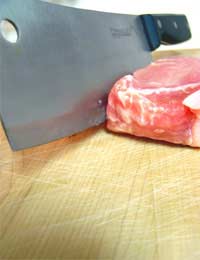Basic Kitchen Knife Skills

Using a knife effectively is an important skill in the kitchen and a good set of knives is an important piece of kitchen equipment.
Japanese sushi chefs train for many years to get the slices of fish cut perfectly for sashimi, not to mention the delicate knife work that decorates their food.
Trainee chefs in the UK spend a considerable amount of time during their NVQ qualifications learning good knife skills and also how to look after their knives.
Kitchen Equipment
A decent set of knives is a good addition to a kitchen and any serious home cook would be wise to invest in a quality set with strong blades and well constructed handles. It is widely appreciated that Japanese and German brands are the hardest wearing, although most decent knife sets can last you well as long as you clean them carefully and keep them well sharpened.It is a common misconception that sharp knives are more dangerous. Whilst this may be true in other situations, in the kitchen and used with some care, a sharp knife can actually be easier to use and therefore cause less accidents. However, please do take every possible precaution with your knives, keep them well out the reach of children and do not allow children to use them unsupervised. It may be better to keep your quality, sharp knives just for adult use anyway.
Chopping
Basic knife skills start with good chopping. Practice with an onion and the largest knife in your cookware set and make sure you clear your workspace and have a good chopping board. After removing the tough outer layers, slice the onion in half from root to tip. Get used to the feel of the knife cutting through the onion and let the weight of the handle guide you, keeping your fingers tucked in carefully, as though your hand was a claw over the onion.Preparing Meat
You will need to use the medium sized knife from your set for preparing meat. For jointing a bird, it is also helpful to use a pair of scissors, although you can buy special poultry scissors, as long as you was them thoroughly a normal kitchen pair will do.For cutting and preparing meat, you may wish to use a small knife. Tasks such as taking the fat off small pieces of meat, or scoring fat on roasting joints will require a medium sized knife. Again, make sure your knife is sharp and allow the weight of the handle to guide you. Many Chinese chefs prefer to use a large cleaver for such tasks, but this can take a lot of getting used to.
Filleting Fish
Many home cooks are daunted at the prospect of filleting fish, but it is very easy if you allow yourself to be guided by the fish bones and use the right knife. Your kitchen equipment should include a filleting knife – it has a narrow, flexible blade. By allowing the movement in the knife to follow the line of the main bone in the fish, keeping as close as possible to the bones, you will soon get a feel for a perfectly filleted fish.It is also worth adding a pair of tweezers to your kitchen equipment alongside your knives, specifically to be used for taking out small fish bones.
- Homemade Food With No Special Equipment
- Encouraging Children to Cook
- The Science Part - Simple Kitchen Physics
- Using your Freezer Effectively
- Using your Fridge Effectively
- Understanding Cooking Terms
- Hygiene in the Kitchen
- Understanding Basic Cooking Techniques
- Know Your Oven Temperatures
- Using Seasonal Produce
- Simple Recipes to Make with Your Children
- Teaching Your Children Basic Cooking Skills


Re: Caring for Your Cooking Equipment
Is it possible to purchase protective blade covers for a Cooks Essential mini food chopper.
Re: Little Touches to Impress Without the Stress
Hi, Years ago my mom bought one of your hand held mixers. Sadly when she passed I obtained it and love it.…
Re: Caring for Your Cooking Equipment
23cm pan. Double handle and lid. Lid handle has broken. Non stick lining has eroded off.
Re: Still in the Box? Equipment That Never Gets Used
Air Fryer model No: 805223. 1400w (White). Has been put away without cleaning properly for quite a long…
Re: Still in the Box? Equipment That Never Gets Used
Do you have a manual for the Air fryer model 805933. Thank you
Re: Five Things You Didn't Know You Could Make in a Slow Cooker
Is it possible to replace a translucent condensation collector? I have mislaid mine. I…
Re: Essential Baking and Cooking Equipment
Hi, I wonder if you can give me some advice. I have been a fan of Cooks Essential cooking pans for many years and…
Re: Cooking for a Crowd - Basic Ideas with Great Results
I would love some recipes for pressure cooker or a recipe book
Re: Caring for Your Cooking Equipment
Can I purchase a handle for a frying pan, it is spring loaded, my wife dropped it and has broken.
Re: Slow Cooker Puddings
Holsgirl - Your Question:What size pudding basin should be used for Sticky Toffee Pudding and Chocolate Pots?Thanks